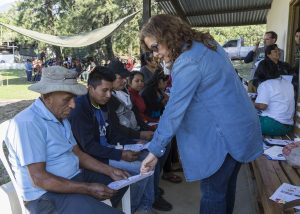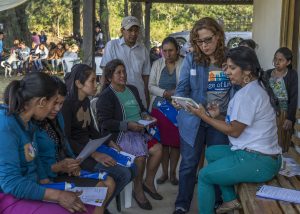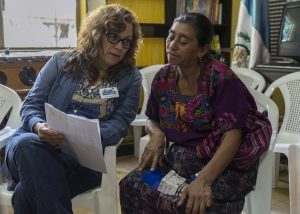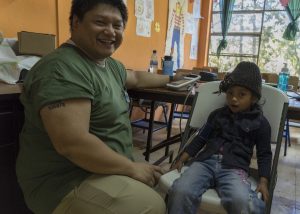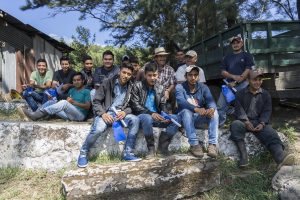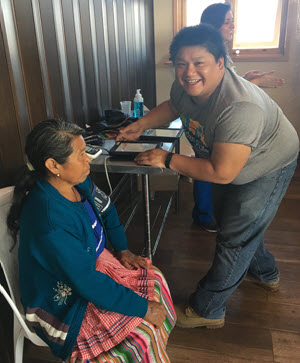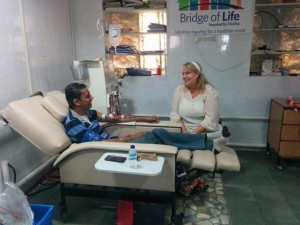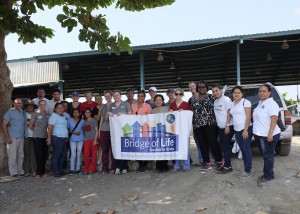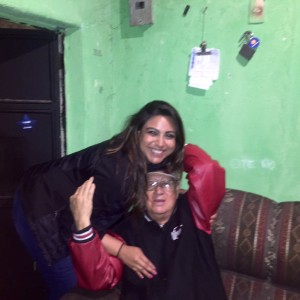Bridge of Life Up Close
How Providing Nutrition Education in Uganda Fed My Soul
I am living my life to the fullest! Bridge of Life (BOL) gave me the opportunity to learn, to serve and to grow spiritually during my recent volunteer experience on their chronic disease prevention mission in Uganda in March 2019.
Having access to health care is a right for everyone, especially for those with chronic illnesses. Many of the Ugandans we met had no access to health care due to the rural locations they live in and their financial situations. Many also reported not being able to afford necessary medicine. Our goal was to reach out to as many people as possible and to provide every individual with free chronic disease screening and prevention education.
 Each patient we met had a story to tell, but one patient’s story in particular touched me deeply.
Each patient we met had a story to tell, but one patient’s story in particular touched me deeply.
In a small village located near Lake Bunyonyi, we met a young man with type 1 diabetes and severe calorie/protein malnutrition. His fat and muscle depletion were clearly visible. He had traveled a very long distance by boat and came to us with the hope that we could help with his condition.
His story was hard to hear, let alone to live. He fully depended on insulin to survive, which required him to check his blood glucose daily. He had a glucometer at home but no strips to check his blood sugar. His daily calorie intake was estimated around 400 to a maximum of 600 kcal (the average for a male is 2,500 kcal!), and his only source of protein was half a cup of beans per day. He could not afford eggs or fruits and vegetables. For those of us in the dietetic field, we certainly understood the severity of his condition.
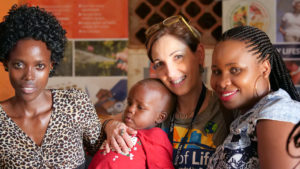 With the help of a local translator, we were able to educate him on the signs and symptoms of high and low blood sugar levels. The translator happened to have connections to local health care facilities and offered to refer him to a clinic in a nearby town. I felt so happy and fulfilled knowing that he was not returning to his village empty-handed! We were able to return the hope that he came to us with. And I now remind myself every day that this patient’s story could easily be MY, or anyone else’s, story.
With the help of a local translator, we were able to educate him on the signs and symptoms of high and low blood sugar levels. The translator happened to have connections to local health care facilities and offered to refer him to a clinic in a nearby town. I felt so happy and fulfilled knowing that he was not returning to his village empty-handed! We were able to return the hope that he came to us with. And I now remind myself every day that this patient’s story could easily be MY, or anyone else’s, story.
This quote from Lilla Watson, an indigenous Australian, was presented to our team on day one of our mission, and it rang very true by the final day of the trip: “If you have come here to help me, you are wasting your time, but if you have come because your liberation is bound up with mine, then let us work together.”
I know we touched many people’s lives on this mission. But what is even truer is how much the Ugandan people impacted the core and souls of OUR beings. I hope that my story touches YOU to the core. And if it does, I encourage you to get involved, to get out of your comfort zone and to join BOL in serving humanity!
A People’s Resilience: The Importance of Serving Syrian Refugees
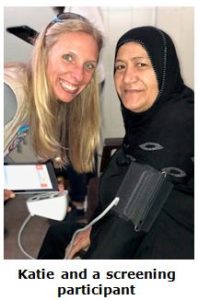 Before Bridge of Life (BOL)’s mission to Jordan in April 2018, I thought of the Syrian conflict as a distant global problem. I didn’t consider the individual story of each Syrian and I overlooked the fact that, given their circumstances, they far too often don’t have opportunities to represent themselves. The conflict isn’t given the same coverage it used to have – or maybe our ears are just going deaf to their continual crisis. After completing this mission, I felt a sense of responsibility to share some of what I learned and witnessed.
Before Bridge of Life (BOL)’s mission to Jordan in April 2018, I thought of the Syrian conflict as a distant global problem. I didn’t consider the individual story of each Syrian and I overlooked the fact that, given their circumstances, they far too often don’t have opportunities to represent themselves. The conflict isn’t given the same coverage it used to have – or maybe our ears are just going deaf to their continual crisis. After completing this mission, I felt a sense of responsibility to share some of what I learned and witnessed.
Like most people that BOL serves, the Syrian refugees that visited our mobile clinic live in extreme poverty. They often live together with dozens of other people in small apartments, shacks or tents. Hygiene is difficult – some don’t have running water or electricity. Zaatari, the main camp in Jordan, is in the desert where many plants or animals can’t even survive. But back in Syria, the refugees’ lives were much different.
Many of the patients we served were teachers, doctors, graphic designers, lawyers, engineers, and store owners. Some had homes, cars and businesses. Their children went to school and had ambitions to secure important jobs. Some people we screened already had in-depth knowledge about the chronic illnesses we were testing for. They would see their blood pressure reading, for example, and say, “Oh, that’s too high. It must be from the stress.” The consequences of the war came to life for our volunteer team – people fled Syria to save their families’ lives. They kissed the walls of their homes goodbye as they escaped to get their families to safety.
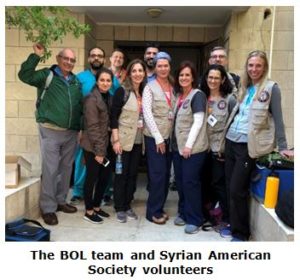 The circumstances that our patients faced in Syria were beyond my comprehension. In 2010, what started as peaceful demonstrations ended in civil war. Homes and schools in the cities were bombed, and people often fled to the countryside where there was no food, water or electricity. Parents were afraid to send their children to school. It was commonplace for children to hear explosions and witness death.
The circumstances that our patients faced in Syria were beyond my comprehension. In 2010, what started as peaceful demonstrations ended in civil war. Homes and schools in the cities were bombed, and people often fled to the countryside where there was no food, water or electricity. Parents were afraid to send their children to school. It was commonplace for children to hear explosions and witness death.
We visited one organization called Souriyat Across Borders that serves amputee children impacted by the war. We treated people who the war had left with severe burns or crooked legs. Young or old, everyone seemed utterly exhausted.
We served one man who had to leave all his belongings when he came to Jordan. He didn’t even have time to take his shoes and arrived in Jordan wearing flip-flops. Today, he and his family are living in Irbid with nothing. One volunteer commented to the man on how difficult this time must be for his family. But the man responded, “I just thank God that we are okay.” The resilience we encountered from patients was 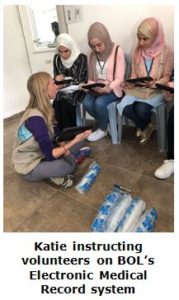 astounding! Still, countless other people I spoke to were separated from their families. One woman cried, “How can I start over when my daughter is still there?” Many patients shared photos of loved ones with us, and almost everyone had friends and family that died in the war. Sometimes people didn’t know if their loved ones were dead or incarcerated.
astounding! Still, countless other people I spoke to were separated from their families. One woman cried, “How can I start over when my daughter is still there?” Many patients shared photos of loved ones with us, and almost everyone had friends and family that died in the war. Sometimes people didn’t know if their loved ones were dead or incarcerated.
On the evening of our last day in clinic, our team (which included a group of Syrian doctors and medical students) went to a traditional Syrian restaurant for dinner. The restaurant had a live band that filled the room with Syrian music, perhaps some of the most beautiful music I’d ever heard. It didn’t take long for all the Syrians to join together in song and dance, and there was this overwhelming sense of belonging. It was truly a sublime moment.
After this trip, I no longer think of pity when I think of the Syrian refugees. Instead, I think of people leaving Syria in search for dignity and safety. And I think of courage, resilience and the will to thrive.
Humanity and Hope: My Experience Screening Syrian Refugees in Jordan
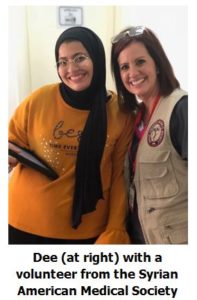 I’ve participated in previous Bridge of Life (BOL) missions, but the Jordan screening I attended in April 2018 evoked the most emotions for me. In partnership with the Syrian American Medical Society, our volunteer team of eight DaVita Kidney Care teammates screened over 1,000 displaced Syrian refugees for chronic diseases, including hypertension, diabetes and kidney disease. This mission was so different because of the population’s history of all they have been through and continue to endure.
I’ve participated in previous Bridge of Life (BOL) missions, but the Jordan screening I attended in April 2018 evoked the most emotions for me. In partnership with the Syrian American Medical Society, our volunteer team of eight DaVita Kidney Care teammates screened over 1,000 displaced Syrian refugees for chronic diseases, including hypertension, diabetes and kidney disease. This mission was so different because of the population’s history of all they have been through and continue to endure.
The people of Syria have suffered far more than I could EVER imagine in my lifetime. Their homes have been destroyed. They have lost loved ones. Some of their family is still back in Syria, and they have no hope of reuniting. They can’t go home when they have nothing to go back to, no resources to rebuild and when it’s not safe to return.
 But I could see the impact that our mission and our volunteers had on the men, women and children who came to our screening. Despite the safety they found in Jordan, the refugees struggle to make ends meet every day and to provide for their families. This mission provided them with basic healthcare services they no longer have access to. And it reminded them that they are still people in this world who care about their health and happiness.
But I could see the impact that our mission and our volunteers had on the men, women and children who came to our screening. Despite the safety they found in Jordan, the refugees struggle to make ends meet every day and to provide for their families. This mission provided them with basic healthcare services they no longer have access to. And it reminded them that they are still people in this world who care about their health and happiness.
During my time in Jordan, I saw smiling faces of men, women and children. I saw people making the best of their situation with grace. I remembered receiving hugs, kisses and numerous invitations to visit the refugees’ “homes” for dinner and to visit them if I ever came back. I remembered one man who called his American friend and let me talk to him just because we both are American and speak English. I recalled how I saw one man carrying his son with special needs over his shoulder just so he wouldn’t have to leave him alone while he and his wife attended the screening. I saw babies of all ages – a reminder of how these people would continue to thrive despite all they had 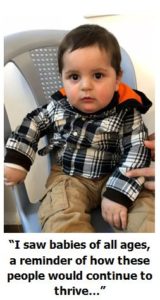 endured. Life has a way of going on!
endured. Life has a way of going on!
What we accomplished on this mission seemed so small compared to a need that is so great, but to the refugees, it meant so much. A smile, a hug, a laugh, a sticker for a child…showing them a little kindness and respect made more of an impact with them than anything else. And the opportunity for them to check on their health, meet with a physician and receive health education – it was such a simple act on our end but an incredible gesture for them. They are survivors!
My cup is so full right now that I can’t even describe how I truly feel. BOL has done wonderful things, but this is, in my opinion, the most important mission they have ever completed. I am so thankful that I got to be a part of it and would do this full-time if I could. I am grateful and proud to work with an organization that provides healthcare to those most in need around the world and can’t wait to go back. Just tell me when!
What I Learned from Educating Guatemalan Coffee Farmers on Kidney Disease Prevention
I signed up with Bridge of Life (BOL) as a volunteer because I felt the need to do something with extra meaning in my life. As a younger woman, I had the chance to travel South America and dabbled a bit in family planning and breastfeeding education, and, boy, did I feel an enormous sense of reward. So I was thrilled when I received a call for an interview from BOL and even more thrilled when I found out the mission would be to Guatemala.
I had visited Guatemala about 20 years ago, just as their civil war was ending. I was a tourist inspired by the love of beautiful textiles, the Incaparina case study in college (a study on nutrition) and my Guatemalan friends and patients in Los Angeles. They expressed their love of country with a mixture of pride and sadness for the conditions they fled back home. I had to experience Guatemala for myself. As I travelled from the most “touristy” places, such as Tikal, to some of the smallest towns in Huehuetenango, I kept telling myself I would come back some day but in a different capacity. I hoped to put a little grain of sand in the construction of a brighter future for those who struggle to create a better life for their families. I have been fortunate enough all of my life to have food, clean water, a home, access to healthcare, and more, so this opportunity was a reminder of how many people in this world still live in poverty and do what is needed to survive.
The experience on the coffee farm in Guatemala was very personally rewarding, a dream come true and then some. Our days on this chronic kidney disease screening mission started early, with station set-up at designated locations. Shortly after, the flow of patients started and didn’t stop until the last person was seen, usually in the late afternoon. I helped a for a short time at the registration desk but was then assigned to the preventative education station, where I would remain all three days having one of the best times of my life, despite how exhausted I was.
I felt that the participants were highly appreciative to learn their screening test results and information on how to better maintain their kidney health. And I trusted that most people who I saw would make at least some change in their lives and that of their families based on this education. Sometimes those small changes can make a great difference in the long run, and that belief fueled my energy to do justice to their needs.
As with most education, I also began to learn new things even as the teacher, but in this case the lessons were so very humbling. When I tried to educate on drinking more water, I learned that not all water is “equal.” There is “pure water,” and then there is gaseosa or “Coke water” – the preferred drink since most of the workers have limited access to good drinking water. And, if you are going to buy bottled water, you might as well get the sweet stuff and get some pleasure out of it (and for most, some much needed calories). When I tried to teach about integrating more vegetables into diets, I learned the names of the green, leafy vegetables that these individuals consume and that most people really enjoy them, but there is not enough water to grow them at home, and vegetables from the market often spoil within two days. When I tried to talk about the need for protein, I learned that most eat “vegan,” but only by necessity, not by choice. And I learned that one chicken can feed 10 people but is a luxury meal that’s reserved for once a week (maybe).
When I tried to educate participants about their lab results, I learned that many individuals had never even seen a doctor, and if they had, that lab tests and results were never explained to them (if they even received any tests at all). As I continued to provide preventative education, I learned that these individuals appreciated silly jokes by shyly laughing as I tried to make them feel more comfortable in a didactic environment that they were unfamiliar with. Getting a formal education is not much of an option in a society where people are put to work at a very early age to help their family survive.
But perhaps the greatest thing I learned is that, despite their struggles, the rich Mayan culture of these people shines through. With only a few handfuls of beans and some corn tortillas to sustain them, the women wrap themselves in their beautiful, colorful huipiles, the men prepare themselves for the day, and they all make the long, daily trek to the coffee farm motivated by the love of their children and families.
A Stirring Reality: Screening Guatemalan Coffee Farmers for Kidney Disease
 Chronic kidney disease is becoming a common illness in rural areas of Guatemala and particularly for agricultural workers due to factors such as long workdays, limited access to proper hydration and work labor.
Chronic kidney disease is becoming a common illness in rural areas of Guatemala and particularly for agricultural workers due to factors such as long workdays, limited access to proper hydration and work labor.
As part of our Screening & Prevention Program, Bridge of Life (BOL) is working with in-country partners to provide chronic kidney disease screenings to different agricultural workers, such as coffee farmers and banana plantation workers, in Guatemala. In March 2017, BOL and a team of volunteers traveled to Antigua, Guatemala and screened over 800 coffee farmers and their families for chronic kidney disease over World Kidney Day at Bella Vista Farm.
Read about our team’s firsthand experiences in the field, conversations with the coffee farmers and our volunteers’ own personal stories in our blog series from this mission, A Stirring Reality: Screening Guatemala Coffee Farmers for Kidney Disease. Check out the first two chapters, and stay tuned for future chapters announced on our Facebook page!
Chapter 1
“Screening in Guatemala: A Firsthand Account of the Daily Lives of Coffee Farmers,” by Katie Chandler, Program Director of Operations, Bridge of Life
Chapter 2
“True Life: I Work on a Coffee Farm,” by Jesse Casco, Patient Care Technician, DaVita Kidney Care
True Life: I Work on a Coffee Farm
It was halfway through the first day of Bridge of Life (BOL)’s chronic kidney disease (CKD) screening event at Bella Vista Farm in Antigua, Guatemala, when it dawned on me—“I thought I knew, but I had no idea.” Yes, it was an episode of MTV’s True Life. For those of you who aren’t familiar with it, True Life is a long-running television show which documents specific life experiences and the people living them. This week’s episode was titled, “True Life: I Work on a Coffee Farm.”
Uncertainty is a catalyst for speculation. This being my first shot at world health services, my expectations from a medical mission like this one weren’t specific. I had created wonderful stories in my head of how simple and scientific this trip was going to be. CKD is an epidemic in this region, and we were going to gather data and get to the bottom of it. And, on the way, we’d help educate and treat those in need. Sounds easy, doesn’t it? I mean, I like helping people. The idea of simple was eviscerated when I began taking vitals for the first of many coffee workers’ children.
I asked the first child, “Wait, you’re 15?” He replied, “Yes.” With a smile, I asked if he was just hanging out with his mother or father today. He replied, “No,” which led me to ask, “Do you work here?” The boy looked at me, smiled and said proudly, “Yes!” My next question was, “For how long?” “Three Years,” was his response. I was completely naïve to the idea that it was commonplace for people in this area to begin working on a farm at such a young age. At 15, I was attending high school, and the only labor I endured was taking out the trash, cleaning my room and washing dishes from time to time.
I also encountered a young man who asked me about my Star of Life tattoo on my right arm. The man asked if I was a firefighter, and I replied, “Yes, a volunteer.” The young man’s face lit up: I symbolized something to him, which filled him with pride. He, too, was a volunteer firefighter, but in Alotenango. And on this day, he connected with someone from a completely different world, but with the same passion. We shared photos of our fire trucks and squad members and a few stories. At first, I wasn’t sure what to make of this interaction, but I was still early on in the week’s journey.
As the days progressed, glimmers of our work’s progress were evident. The most luminous example for me occurred on the way back from the farm. I was in a car with three other volunteers, and we were reminiscing on a job well done for the week. Our driver received a call, and after hanging up, mentioned that a woman we screened earlier in the day made it to the hospital in Guatemala City. To be honest, I had been completely caught up in the collection of data and future interpretation – analyzing data is a habit of mine. But I had heard about a patient who, after all of our tests, showed strong evidence of Stage 5 kidney disease. The driver mentioned she would receive dialysis treatment and was impressed that, without this screening, she would have had no knowledge of her health which may have led to her passing. In the moment of silence that followed, I reached a level of certainty that erased all my speculation: this was the impact that our team had on the people here. It wasn’t just the data that we needed. It was the support we were giving the people here that was impactful. In that moment, who cared about the data? I didn’t—in fact, I said, “We saved someone’s life today.”
I reflect on a week that I’ll never forget. In fact, I’d like to expand on what our team did in Guatemala this week. I’d like to see how far our impact can truly reach. After all of the interactions I’ve had with the people and workers in Guatemala, I have a much more certain understanding of BOL’s goal: we gave these people life, and in return, they gave us life. The level of fulfillment from that realization is astonishing. I walked into this mission with one expectation and left with a completely different and humbling one.
Screening in Guatemala: A Firsthand Account of the Daily Lives of Coffee Farmers
 Each morning, thousands of Guatemalan farmers wake up long before the sun has started to rise to make the three-hour trek to coffee plantations outside the city of Antigua. Many are mothers with their young children swaddled in aguayo (a woven blanket used to carry items) strapped to their backs. They slip on their plastic chinelas (flip-flops), fill their recycled Coca-Cola bottles with water from their shallow well and begin the long, familiar hike down the dark dirt road. The farmers know this journey well: many first started down this same path when they were on their own mothers’ backs. Days on the farm stretch until the sun is ready to set, and the workers make the same hike back home in the evening. They are lucky to catch six hours of sleep before it is time to do it again.
Each morning, thousands of Guatemalan farmers wake up long before the sun has started to rise to make the three-hour trek to coffee plantations outside the city of Antigua. Many are mothers with their young children swaddled in aguayo (a woven blanket used to carry items) strapped to their backs. They slip on their plastic chinelas (flip-flops), fill their recycled Coca-Cola bottles with water from their shallow well and begin the long, familiar hike down the dark dirt road. The farmers know this journey well: many first started down this same path when they were on their own mothers’ backs. Days on the farm stretch until the sun is ready to set, and the workers make the same hike back home in the evening. They are lucky to catch six hours of sleep before it is time to do it again.
In the fields, the farmers work relentlessly, rarely taking a break as they can earn 50 quetzales (roughly $6.50) in a day if they can pick 100 pounds of coffee – a nearly impossible task. They turn to their children to help meet their quota. The children pitch in eagerly, not knowing that most of them will continue working in the fields until eventually their callused, crippled hands have grown too old to do the work.
Bridge of Life (BOL) had the opportunity to spend three days at Bella Vista Farms to host a kidney disease screening for 811 coffee workers. We tested blood pressure, urine and blood. We held health education workshops for the farmers to better understand their health results and learn the causes behind some of their poor health conditions and how to improve related behavior. Patients at risk saw a nephrologist and received any necessary medication for free. We learned that the farmers’ work takes a toll on their health. Hypertension, likely caused from stress, is a reality for far too many. Many of the farmers also suffered from diabetes. Health issues are ignored, or perhaps they just never recognized the wa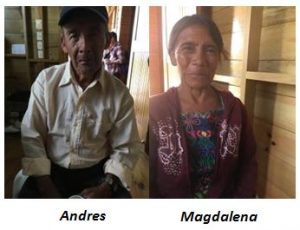 rning signs.
rning signs.
Several of the farmers shared their personal lives and stories with us:
Andres is 75 years old and doesn’t know any life other than one working in the fields.
Magdalena still picks coffee at 62 years old. She can’t quite remember when she started, but is certain that it’s been more than 50 years.
Mirian is 24 years old. She attended school only through the third grade. She has two children. She makes the three-hour hike to work with her youngest tied to her back and her oldest on her hip. While she works, the two children play under the shade of the coffee trees. She wants another life for her children, but admits that her toddler already knows how to pick and has started to help her in the fields.
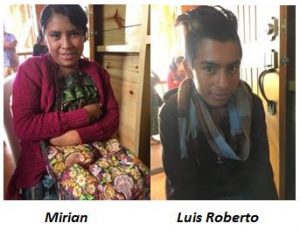 Luis Roberto is a stylish 18-year-old young man. He started working full time on the plantation at 13. “I left school for my family,” he said. “That’s what we all have to do for our families.”
Luis Roberto is a stylish 18-year-old young man. He started working full time on the plantation at 13. “I left school for my family,” he said. “That’s what we all have to do for our families.”
These farmers’ situations are not isolated cases. Their stories are similar – ones that are replicated and re-played among generations of farmers, where young children are willing to put their own dreams aside to help their mamá or papa meet their 100-pound quota and the cycle of poverty continues. People never start or drop out of school to find a job in agriculture.
The level of poverty the farmers experience became very evident when I asked Fidelia, a 30-year-old woman, if she has access to clean water at work. She responded very nonchalantly: “We can get water to drink at work when rain falls from the sky. Otherwise, we have to bring it from home.”
Our team also saw firsthand the consequences of illness that went undetected for far too long…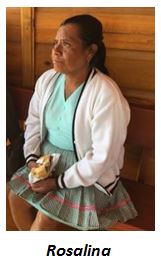
Rosalina is 53 years old. Despite the fact that her mother is diabetic and her father is hypertensive, she rarely thinks about her own health. A day without work means a day without food, and so Rosalina, like most of the other farmers, ignored the warning signs. The weeks before we arrived in Antigua, Rosalina’s health took a turn for the worse. She started vomiting and feeling dizzy and fatigued. Her vision blurred. Still, Rosalina went to work each day. After screening Rosalina, we learned that she was living with Stage 5 kidney disease and didn’t know it. Our team counseled Rosalina about her health and sent her in an ambulance to Guatemala City to get the healthcare services she needed. In this case, our screening program was not just a matter of prevention – it offered lifesaving treatment.
Currently, there is no identified cause of chronic kidney disease (CKD) among agricultural workers. Unlike normal cases of CKD, CKDu (chronic kidney disease of undetermined causes) has a rapid onset with proteinuria and albumin (usually early indicators of kidney disease) noticeably absent until later stages of the disease. Many speculate that it is caused by heat stress, dehydration or pesticides. Perhaps it’s the combination that creates the perfect storm.
What is for certain is that this new form of CKD needs continued research. The farmers already face so many challenges and, for most, treatment is out of reach. BOL is committed to working alongside these farmers to understand the causes of and solutions to this fatal disease. The road may be muddy and long…but we will get there!
COMING SOON! Stay tuned for our next chapter in this blog series …
True Life: I Work on a Coffee Farm, by Jesse Casco, Patient Care Technician, DaVita Kidney Care
Find the link on BOL’s Facebook page
Returning to the Dominican Republic to Serve
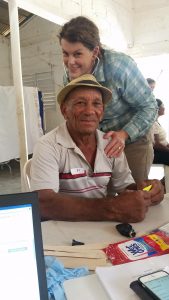 When I was 16 years old, I had an opportunity to go to the Dominican Republic (DR) on a dental mission. At the end of my 3 weeks there, I saw a group of people in the village that were sleeping and waiting in line for something. Out of curiosity, I asked what they were waiting for and they answered “doctors from America.” I thought it would be great to see how the doctors worked and asked, when they would be there so I could observe. I was shocked to find out 3 days later! At that moment, at age 16, I decided that I wanted to become a doctor who would come earlier to help the many people who had traveled and were sleeping outside for 3 days/nights. When I found out about this opportunity to go back to the DR with Bridge of Life (BOL), I had to return 30 years later!
When I was 16 years old, I had an opportunity to go to the Dominican Republic (DR) on a dental mission. At the end of my 3 weeks there, I saw a group of people in the village that were sleeping and waiting in line for something. Out of curiosity, I asked what they were waiting for and they answered “doctors from America.” I thought it would be great to see how the doctors worked and asked, when they would be there so I could observe. I was shocked to find out 3 days later! At that moment, at age 16, I decided that I wanted to become a doctor who would come earlier to help the many people who had traveled and were sleeping outside for 3 days/nights. When I found out about this opportunity to go back to the DR with Bridge of Life (BOL), I had to return 30 years later!
To start, this was an amazing experience – I worked long hours, in heat and at times difficult conditions, but loved every minute of it. I anticipated a similar experience as I had 30 years ago – and I was pleasantly surprised that the accommodations were very nice – with A/C, good food and the location was beautiful.
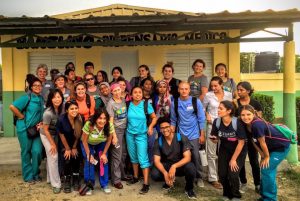 Each day we went to a batay (a small village) and would see 67-150 patients. Each morning we traveled 30-40 minutes to each batay and set up a triage area, lab, clinical area, and pharmacy. There was always a line formed before we arrived. We also had a dental team – which was a bonus! I worked directly with an interrupter, a scribe (a Wayne State or CSU student) and used a great Electronic Medical Records system (EMR) – called Timmycare, used by BOL’s in country partner Timmy Global Health. The EMR allowed me to review previous visits for each patient as well as previous treatments, etc. There is a full time doctor, Dr. Garcia and Anna (the coordinator) who helped with each and every aspect of the day. We had 3 volunteers to provide clinical care – myself, a Nurse Practitioner from a Philadelphia DaVita clinic and a DaVita Medical Group family practitioner from the LA area.
Each day we went to a batay (a small village) and would see 67-150 patients. Each morning we traveled 30-40 minutes to each batay and set up a triage area, lab, clinical area, and pharmacy. There was always a line formed before we arrived. We also had a dental team – which was a bonus! I worked directly with an interrupter, a scribe (a Wayne State or CSU student) and used a great Electronic Medical Records system (EMR) – called Timmycare, used by BOL’s in country partner Timmy Global Health. The EMR allowed me to review previous visits for each patient as well as previous treatments, etc. There is a full time doctor, Dr. Garcia and Anna (the coordinator) who helped with each and every aspect of the day. We had 3 volunteers to provide clinical care – myself, a Nurse Practitioner from a Philadelphia DaVita clinic and a DaVita Medical Group family practitioner from the LA area.
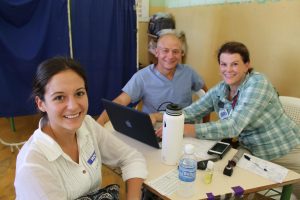 One thing that stood out for me was all the wonderful children that I saw – sadly many had infections, lice, as well as allergies. As I look back, I think one particular 38-year-old mother of 4 children stands out to me. I diagnosed her with new onset type 2 diabetes (her glucose was over 300). Normally in the U.S. I would discuss diet, food choices and start medications. I learned that there is very little availability for green vegetables in the DR. Most patients in the Dominican eat root vegetables potatoes, yucca, maybe carrots occasionally – none of these are ideal for diabetes patients. In spending time with this patient, I remembered that here in the U.S. it is a privilege to have availability of so many healthy vegetables.
One thing that stood out for me was all the wonderful children that I saw – sadly many had infections, lice, as well as allergies. As I look back, I think one particular 38-year-old mother of 4 children stands out to me. I diagnosed her with new onset type 2 diabetes (her glucose was over 300). Normally in the U.S. I would discuss diet, food choices and start medications. I learned that there is very little availability for green vegetables in the DR. Most patients in the Dominican eat root vegetables potatoes, yucca, maybe carrots occasionally – none of these are ideal for diabetes patients. In spending time with this patient, I remembered that here in the U.S. it is a privilege to have availability of so many healthy vegetables.
On this trip I was reminded from my trip 30 years ago that there continues to be a strong need in the DR for adequate medical care and of the amazing people that reside there. I was so grateful to share this special experience all my colleagues from the US (my fellow volunteers). And on this trip, I relearned why I went into medicine in the first place.
I would encourage all of my teammates who have an interest, to apply to volunteer. This is a wonderful opportunity to practice medicine where there is such a tremendous need and each person appreciates you being there. Each day, as we pulled away from the batay, I knew I made a difference – truly a full circle experience for me.
The Faces of Kidney Disease in India
Recently, I traveled to India to take part in a Bridge of Life (BOL) medical mission and conduct some other business-related activities. It was a jam-packed itinerary with four in-country flights in eight days, spanning the distance from Delhi to Bangalore with stops along the way in Jodhpur, Mt. Abu and Mumbai.
First – India! Wow. What a fascinating country that jars the senses with its mix of the modern and the ancient, efficiency and confusion, and what has to be the most chaotic traffic in the world. Rickshaws and camels share the road with cars and motorbikes, and rules of the road are nonexistent. Horns blast constantly both as a way to promote safety (“I’m passing you”) and express frustration (“why are you passing me?”). Being a passenger requires a Zen-like sense of calm and acceptance of the environment. I also found not looking out the driver’s window to be a helpful strategy.
It’s impossible to spend even several weeks in India and feel like you begin to understand this complex country of contrasts that is simultaneously racing toward its economic destiny while struggling to overcome tremendous poverty. According to the World Health Organization, up to 60% of the population does not have access to adequate healthcare provision. And that’s why, for the past eight years, BOL has been providing ongoing medical missions focused on both treatment and prevention while also strengthening the healthcare infrastructure.
Our work began with missions in 2008 to establish dialysis clinics in Jodhpur and Phalodi with our in-country partner, International Human Benefit Services (HBS). In 2013, we helped to upgrade a clinic in Nagercoil in partnership with Holy Cross Hospital and we are currently in the process of expanding two clinics at J. Watumull Global Hospital & Research Centre in Mt. Abu. These dialysis clinics provide lifesaving treatment to people who would likely have no other options.
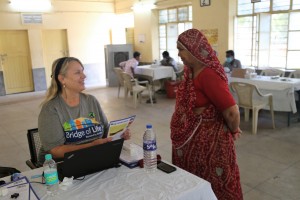
654 individuals were screened for CKD during Bridge of Life’s recent screenings in Jodhpur and Phalodi
I frequently say there’s only one thing better than lifesaving dialysis treatment – not needing treatment in the first place. The way to achieve that is through chronic kidney disease (CKD) screening (testing) and education. In April 2016, we conducted our first CKD Screening Mission in both Phalodi and Jodhpur, India. Over four days, we screened 654 people for CKD and provided each of them with comprehensive education on how to care for their kidneys. Those in late stages of CKD were referred to physicians for ongoing follow-up.
It was humbling to see the men and women of all ages who arrived each day for screening, their gratitude obvious in the smiles and hugs that overcome language barriers (many spoke Hindi and other dialects). Though this was only our sixth CKD screening outside of the United States, I was able to see firsthand the effectiveness of our process, the thoroughness of our education and the vital service we are providing to places with a severe shortage of treatment options. Prevention is the answer in these environments, and we are on the frontlines in delivering it.
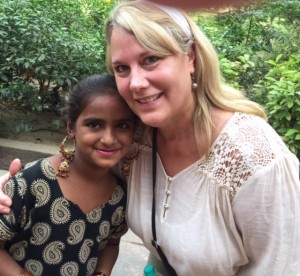
“At BOL, we talk about providing treatment, but what we are really doing is enabling human potential.”
I also visited the dialysis clinic in Jodhpur which our partner HBS is operating. They are providing very affordable and quality treatment in an area where no other clinics exist. Two of the patients I met are young adults in their late 20s/early 30s. Both have advanced degrees and work as teachers despite the treatments they must receive two to three times per week. In talking with them about their lives and interests, I realized what we always understand from these interactions – all human beings basically want the same things in life. This young man and woman want what every young adult wants – to live, love and work and enjoy the simple pleasures that life offers.
At BOL, we talk about providing treatment, but what we are really doing is enabling human potential. And we are proclaiming through our work that every human being deserves the chance to live a healthy and fulfilling life, regardless of where they are born.
I returned from India proud of our work, humbled by our partners who overcome tremendous challenges to provide healthcare and inspired to grow our resources so that we can do more. I won’t forget the faces I saw at our screening and those undergoing treatment. I hope you can see them too.
Beautiful, Unexpected Impact Ripples Are Created Through Bridge of Life
In a small home in Guatemala City in 1994, a young girl danced with her grandfather in celebration of her third birthday. It was her first visit back to Guatemala, her mother’s home country. The home was simple. She felt frequent drops of water on her head from numerous leaks in the roof, and access to daily water was very limited. Yet the music and dancing were all the three-year-old needed for the most perfect birthday celebration.
Fast forward to 2016: this young girl, who is now a bright successful 25-year-old United States citizen, will make another memorable visit to Guatemala and pursue her dream of returning to dance and celebrate once again with her now 87-year-old grandfather.
Liz Lopez, a teammate with the LA/OC VillageHealth Operations team at DaVita, volunteered with Bridge of Life (BOL) on a chronic kidney disease (CKD) screening mission to Trifinio Guatemala this past February. The goal of the mission was to screen 1,000 banana plantation workers for CKD and other non-communicable diseases at the Banasa Farm to gain a better understanding of the major health issues that affect the well-being of these workers. But this mission’s impact ripples began far before the team touched ground in Guatemala City.
The BOL volunteer team met in Dallas to catch a connecting flight to Guatemala City. It was the first opportunity for the team to meet each other face-to-face. Liz introduced herself to the team and shared that her mother is originally from Guatemala City, and that she was eager to give back to the country where her mother was born and where some of her family still lives. As the team prepared to take off, Liz approached me and humbly asked for a favor to spend a short 15 minutes at the airport in Guatemala City to see her family who she had not seen since her third birthday 22 years ago. Liz was clear that she did not want to disrupt the team itinerary but was anxious to see her grandfather and cousins. I quickly decided that Liz would, of course, meet her family at the airport and then spend the evening with them.
Upon arrival at the airport in Guatemala City, BOL’s team of 11 volunteers quickly realized the unexpected impact ripples of Liz’s participation as the team gathered around Liz, her grandfather and cousins. The reunion between Liz and her grandfather, Jorge Chacon, brought tears of joy to Liz’ family and the BOL team as they hugged and danced in excitement of seeing each other again. Countless hugs and pictures continued as the team witnessed the love and happiness the family was experiencing as a result of Liz’ desire to volunteer with BOL and give back to her mother’s home country. The BOL team agreed that this family reunion was the highlight of their mission experience, and that these unexpected impact ripples at the start of the mission set the stage for the rest of their time in helping those in need in Guatemala.
Liz and her grandfather shared just a few short hours together the night of her arrival in Guatemala City. They danced together again, listened to music and shared stories about the rest of their family in the United States. Jorge told Liz she brought love and happiness back into his home. Liz said she certainly could get used to spending days dancing and laughing again with her grandfather. Jorge spends his days walking, reading, watching television, and cooking. He is well-known in his neighborhood and is a friend to many. Jorge’s last wish before he passes is for everyone in his family to share a meal around the dining room table in his home where his children were raised. Liz convinced her grandfather to consider a visit to the United States when she gets married one day.
The dance between a young girl and her grandfather spanned 22 years. The unexpected impact ripples from BOL missions are often not quantifiable from a metrics standpoint. However, their impact is far-reaching. Liz’ story was made possible through her eagerness to volunteer with BOL and give back to her home community. The impact ripples made through BOL will certainly continue, whether they are planned and measurable or completely unexpected.
